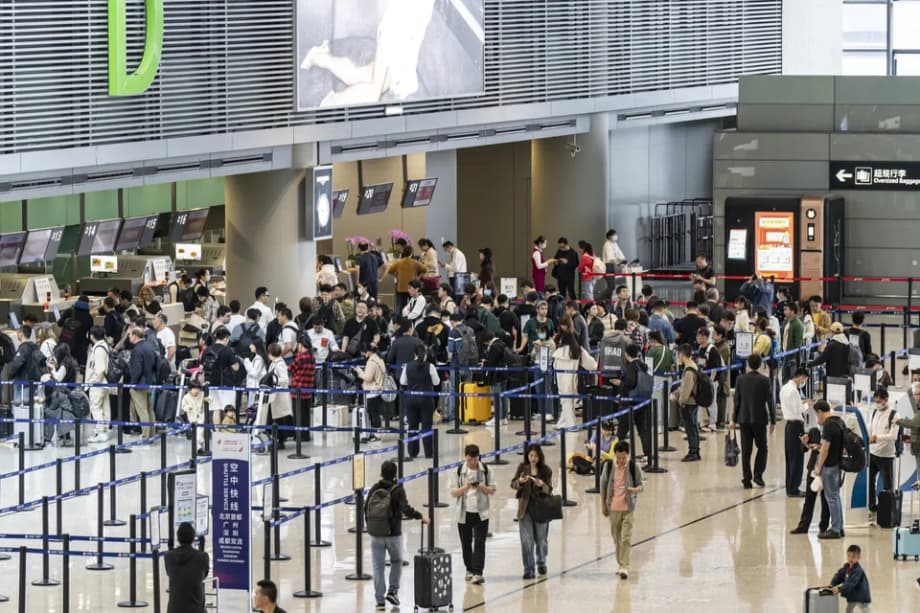Cheap tickets spur travel, but margins stay thin
International airfares for Chinese travelers remain well below pre pandemic levels, and that is reshaping the recovery of China’s state airlines. Industry data show outbound tickets have stayed between 22 percent and 34 percent under 2019 prices on many routes. Lower prices have encouraged more trips and helped rebuild traffic, yet they also limit what airlines earn on each seat sold. That trade off is at the heart of why China Southern Airlines, Air China and China Eastern have struggled to rebuild profitability at the same pace as their passenger volumes.
Cheap fares are a double edged strategy. Discounting helps fill planes, but it weighs on passenger yields, the average ticket revenue an airline collects per passenger per kilometer. The three largest state airlines remained in the red through the first half of the year as yields lagged. Since 2020 the trio has posted a combined loss of about 206 billion yuan, underscoring how deep the hole became during and after the pandemic. The summer travel surge gave them a lift, yet ticket pricing still lacks strength compared with 2019.
Price sensitivity among Chinese travelers is another part of the story. A slower domestic economy, a prolonged property slump and a cautious consumer have pushed many flyers to search for cheaper options or shift to rail when it is competitive on time and cost. That has made it harder for airlines to restore pricing power on many busy domestic and short haul international routes.
Earnings show a summer lift, then a quick fade
The third quarter, typically the strongest period for Chinese carriers, delivered a long awaited boost. Air China posted a third quarter net profit of 4.14 billion yuan, even though that result was slightly lower than a year earlier. China Eastern returned to profit with 3.53 billion yuan after three consecutive quarters of losses. China Southern reported a third quarter profit of 3.84 billion yuan, up from the prior year’s performance. The country’s largest carrier by fleet and passengers, China Southern, also said quarterly revenue reached a record 51.4 billion yuan and net income rose 20 percent year on year. The pattern is familiar: the summer peak can be profitable even in years when the full year result ends in a loss.
Pricing momentum cooled quickly as the market moved into low season. During the week long National Day holiday, average one way domestic fares edged up to about 910 yuan, roughly 10 percent higher than a year earlier. After the holiday, frequencies and prices slipped. From October 13 to 19, average domestic fares fell to about 768 yuan, roughly 12 percent below the prior month’s level. That seasonal whipsaw highlights why sustained profitability for the full year still depends on what airlines can charge beyond the summer peak. Analysts have said the big three could finish 2025 in the black if autumn and winter losses remain contained, but weak yields and intense competition remain headwinds.
Why yields lag despite crowded flights
Yield is a simple idea with large consequences. It measures how much revenue an airline earns for each passenger and each kilometer flown. When fares fall faster than costs, yields compress, even if planes look full. Several forces are keeping yields soft in China. Airlines added capacity quickly to chase rebounding demand. Many travelers are still hunting for bargains. Competition from high speed rail and low cost carriers on short and medium distances is intense. These pressures are most visible on domestic routes and regional international markets that were the first to reopen and ramp up.
Capacity has outrun pricing power
International capacity to and from China has recovered to roughly 85 percent of 2019 levels, but that headline masks important differences. Services to North America are still below one third of pre pandemic activity amid diplomatic frictions and tight bilateral limits. Airlines have poured seats into shorter routes across Northeast and Southeast Asia, where traffic is easier to restore. The result is fierce competition and thinner pricing on popular city pairs. Travel between China and South Korea is a clear example. Capacity on that corridor has rebounded to about 105 percent of pre pandemic levels, aided by visa waivers and tour groups. Analysts caution that while these policies lift headcounts, they do not automatically lift profits, since group travel is highly price sensitive and carriers tend to discount heavily on oversupplied routes.
Domestic rivalry and rail competition
Inside China, airlines added seats throughout the year to capture pent up demand. Low season has brought quick adjustments, with fares sliding once holiday peaks pass. The average domestic fare in mid October dropped to the high 700 yuan range, reflecting both the seasonal downturn and a crowded market. High speed rail exerts steady pressure on air fares on many trunk routes, particularly where rail journey times are competitive. Full service airlines also face growing competition from private low cost rivals that pushed hard into leisure markets and returned to the black earlier than the big three. When lower cost competitors set the price tone on high demand leisure routes, legacy carriers often match discounts to protect share, which pulls yields down across the segment.
International network recovery reshapes the market
China’s aviation regulator has signaled broader network growth through the 2025 to 2026 winter spring season. The Civil Aviation Administration of China (CAAC) expects about 119,500 weekly passenger and cargo flights, up slightly from last year, with international flights rising more than 10 percent year on year. Passenger services by 191 airlines will link China to 83 countries, and cargo routes will expand to 49 countries. The route map is filling out in new directions. Passenger flights with India are set to resume after a five year halt. Carriers are adding new links to Oman and Argentina, and expanding cargo connections to Panama, Chile and Switzerland.
Beijing’s two major airports illustrate how the network is evolving. The share of international passenger flights handled by China’s top hubs has grown, and airlines are spreading bets across more regional points. China Southern has launched a Daxing to Doha service. China Eastern plans to open a direct route to Muscat and add flights to Bali, Phu Quoc, Kobe and Sapporo. Air China intends to operate 452 routes in the season, including 127 international and regional, with about 1,725 daily flights and a 13 percent capacity increase from the previous winter spring schedule. At Beijing Capital International Airport, an operations official described the coming months as steady but growing.
He Yawei, a senior official at the airport’s operation control center, said the expanded network would push daily destinations to a new high.
We are expecting stable growth this season, with new routes to Tbilisi and Abu Dhabi bringing our total destinations to 212.
More routes and more seats improve connectivity and can unlock new demand over time. In the near term, they also add supply that can hold fares down until traffic grows to meet the added capacity. That tension sits at the center of the pricing challenge facing the big three.
Costs, fuel and fleets set the tone for 2025
The global picture offers both relief and new constraints. The International Air Transport Association (IATA) projects that airline profitability will improve in 2025, with net profits around 36 billion dollars on record industry revenue near 979 billion dollars. A key tailwind is an expected 13 percent decline in jet fuel prices compared with 2024, which eases one of the largest line items on airline income statements. Passenger load factors are projected to hit a record 84 percent. Even so, IATA expects passenger yields to fall about 4 percent in 2025 as lower fuel costs and strong competition pass through to ticket prices. Cargo revenues are likely to soften compared with the peaks of the previous two years, and protectionist trade measures are weighing on cargo yields.
IATA’s Director General, Willie Walsh, has stressed how thin airline margins remain despite the headline profit total.
While a 36 billion dollar profit sounds large, it equals about 7.20 dollars per passenger per segment. That leaves airlines sensitive to new taxes, higher charges or a demand shock.
Cost trends beyond fuel also matter. Sustainable aviation fuel production is set to double but will still account for a tiny fraction of total fuel use, and it remains more expensive than conventional jet fuel. The aircraft order backlog exceeds 17,000 jets worldwide, and delivery delays are slowing fleet modernization plans. For Chinese carriers, this mix of headwinds and tailwinds means fuel will help in 2025, but any drop in yields can offset part of that relief. Financial repair remains a priority after years of losses. Flag carrier Air China has announced plans for an A share private placement to raise up to 20 billion yuan, aiming to repay debts and strengthen capital. That kind of balance sheet action gives airlines more room to add capacity where it earns a return and to invest in more efficient aircraft. China Eastern’s early role as launch customer for the C919 narrow body jet points to gradual domestic fleet renewal, which can improve unit costs on trunk routes over time, although ramp up is paced by production slots.
What cheap fares mean for travelers and investors
Travelers are likely to find good deals through the low season and on routes where capacity is most abundant, such as parts of Northeast and Southeast Asia. China to North America remains constrained, so the deepest discounts will continue to cluster on regional flights and domestic markets outside peak holiday weeks. Fares often rise during Golden Week and the winter holidays, then ease again. Passengers who can travel off peak or midweek will still see broad availability at prices below 2019 benchmarks in many markets.
For investors, the focus is shifting from raw traffic growth to pricing quality. Key markers to watch include passenger yields, capacity discipline on overserved routes, the mix of long haul and regional flying, and progress on debt reduction. Ancillary revenue, from extra legroom seats to co branded card partnerships, can cushion yield weakness on the base fare and offers upside for carriers with stronger loyalty programs. Cargo can provide seasonal support, especially during the year end shipping peak for electronics, although its pricing is cooling from previous highs. The third quarter proved that demand is deep, yet sustained profit recovery for China’s state airlines hinges on stronger pricing, careful route planning and continued cost control.
Key Points
- International airfares for Chinese travelers are about 22 percent to 34 percent below 2019 levels, lifting traffic but compressing yields.
- China Southern, Air China and China Eastern remained loss making in the first half, and the trio has accumulated about 206 billion yuan in losses since 2020.
- Third quarter 2025 brought a profit lift: Air China earned 4.14 billion yuan, China Eastern 3.53 billion yuan, and China Southern 3.84 billion yuan.
- China Southern reported record third quarter revenue of 51.4 billion yuan and said net income rose 20 percent year on year.
- National Day week saw average domestic fares near 910 yuan, then prices fell to roughly 768 yuan in mid October as low season began.
- International capacity has recovered to about 85 percent of 2019, while China to North America remains under one third of pre pandemic levels.
- China to South Korea capacity is about 105 percent of pre pandemic levels; analysts warn that oversupply keeps fares low despite higher traveler numbers.
- CAAC’s 2025 to 2026 winter spring schedule plans about 119,500 weekly flights, with more than 21,000 international services and several new routes.
- IATA expects global airline net profits of about 36 billion dollars in 2025, with yields down around 4 percent and jet fuel prices lower by about 13 percent.
- Air China plans to raise up to 20 billion yuan to repay debt and boost capital as carriers balance route growth with financial repair.




